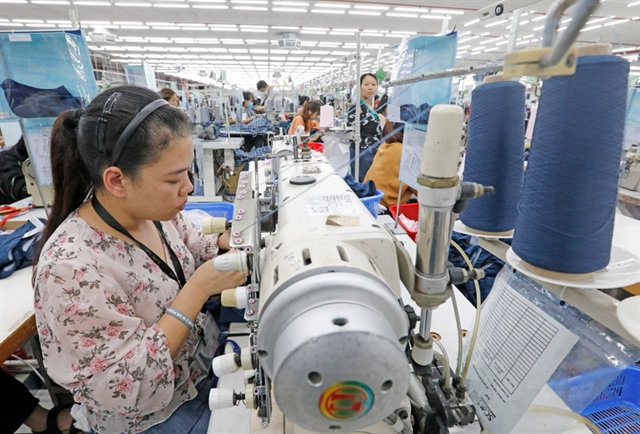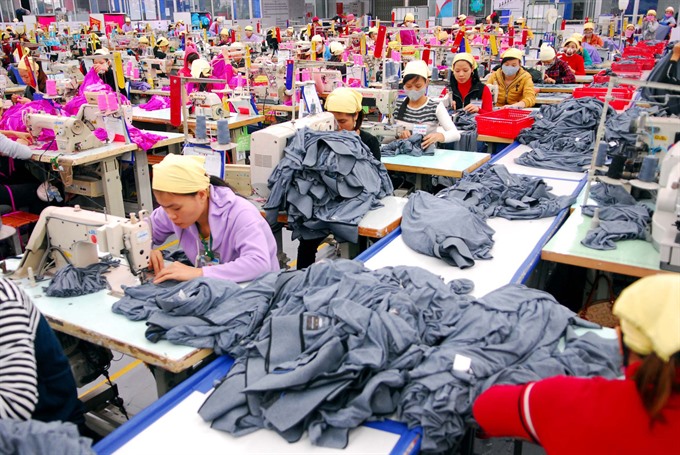 Economy
Economy

Economic growth this year would climb up to 6 per cent on the back of recovery signs shown in the third quarter, falling short of the 6.7 per cent target set by the Government.
 |
| Workers at a textile export company in Ninh Bình Province. A report by the Việt Nam Institute for Economic and Policy Research says significant recovery was seen in import-export activities, with an 8.3 per cent increase in export turnover helping bring about a trade surplus. VNA/VNS Photo Danh Lam |
HÀ NỘI – Economic growth this year would climb up to 6 per cent on the back of recovery signs shown in the third quarter, falling short of the 6.7 per cent target set by the Government.
These figures were revealed in a report tabled at a conference yesterday by Nguyễn Đức Thành, director of the Việt Nam Institute for Economic and Policy Research (VEPR).
The positive third quarter growth also means that inflation would reach the five per cent target set by the National Assembly for the year, the report says.
The VEPR estimates third quarter GDP growth at 6.4 per cent, lifting the growth rate for the first nine months of the year to 5.9 per cent.
It says the manufacturing and processing sectors were key drivers of economic recovery seen in the third quarter, posting growth rates of 6.4 per cent and 11.22 per cent respectively in the third quarter and first nine months of the year.
A decline in mineral exploitation has negatively impacted industrial growth in particular, the report says.
According to the General Statistics Office, the agricultural sector continues to do badly. The sector, which typically accounts for 11-13 per cent of the national GDP, grew a measly 0.05 per cent in the first nine months, contributing just 0.01 per cent to the national economy.
Growth in the forestry and fisheries sectors was also less than in the same period last year.
As of September, the agriculture, forestry and fisheries sectors had grown by just 0.65 per cent, the lowest in the last six years.
Business activities also declined slightly, compared to the last quarter, but there were some positive signs, the report says.
The number of newly-registered businesses as well as the amount of registered capital has increased. However, the number of employees in newly-established businesses has dropped against the same period last year due to lay-offs in the mineral exploitation sector.
The report says significant recovery was seen in import-export activities, with an 8.3 per cent increase in export turnover helping bring about a trade surplus.
Overspending unavoidable
Low revenues hampered the State Budget and overspending was unavoidable, the report says.
“The target of keeping overspending below 5 per cent will not be reached,” Thành said.
Despite many difficulties, the Government was keeping its 6.7 per cent growth target for 2016 unchanged, he noted.
“To reach this target, economic growth in the final quarter should show a year-on-year increase of 8.3 per cent.
“However, the Government should focus more on the quality of economic development, and revise the target to 6.3 or 6.5 per cent,” Thành told the conference.
He said insistence on high economic growth might inflame macroeconomic instabilities and inflict “much heavier costs.”
Other experts at the conference also said that Việt Nam should lower its economic growth target to avoid macro-economic instability. Inflation would be unavoidable in the coming months, they noted, with healthcare costs set to rise in 16 cities and provinces.
Moreover, in the world market, energy prices had recovered while food prices were still unknown. These factors have exerted pressure on Vietnamese prices, pushing inflation to the 5 per cent target.
The VEPR recommended caution in policy making, especially in monetary and credit policies.
“In the coming time, the Government should apply a master plan for trimming the administrative apparatus as well as regular spending by State agencies,” Thành said.
Alongside efforts to improve the current business environment, commercial banks should reduce lending rates to motivate businesses, facilitating stable economic growth, he added.
– VNS




